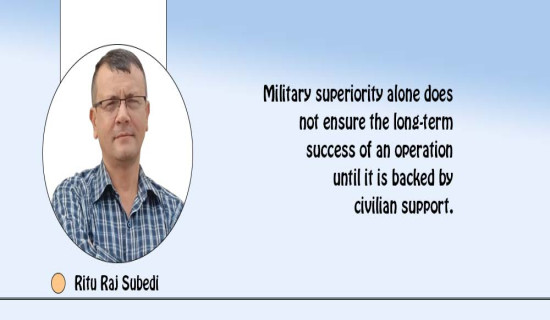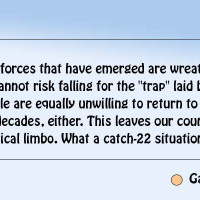- Tuesday, 13 January 2026
A Treaty Without Any Utility?
Seventy-four years have gone by since Nepal and India signed, on 31st July 1950, an accord officially billed as the Treaty of Peace and Friendship. Independent India was barely three-year- old and Nepal was still under the autocratic family rule of Ranas which had begun in 1846. The treaty was formalised in Kathmandu by Prime Minister Mohan Shamsher Rana on behalf of Nepal and ambassador CPN Singh representing India. Obviously, it was not equal protocol-wise, but that did not appear to be the main reason why the Nepali intelligentsia resented the entire process. The foundation of Rana regime was shaky due to people’s demand for democracy. Evolving circumstances encouraged the then prime minister to conclude a pact with new Indian leadership, hoping that it would work as a bulwark for the Rana regime. But his expectations fell flat within months.
That the treaty was drawn up hastily was to be instantly evident in several of the provisions inserted in it having 10 Articles in all. For example, Article 6 and 7, required Nepal to grant ‘national treatment’ to Indian nationals in several areas including businesses and ownership of properties. Of course, it was meant to be ‘on a reciprocal basis’, but it was absurd to think that reciprocity would work out when the asymmetry — in territory and population — between the two countries was too glaring to be overlooked. The 1950 treaty, says former Indian ambassador to Nepal K V Rajan (1995-2000), was a “robust imitation of the 1923 treaty between British-India and the Ranas.” In his write-up in the South Asian Journal in 2005, Rajan admitted that the accord “could not and did not go down too well with many Nepalis who felt that it was unequal, non-credible and undemocratic, and who bristled openly at the suggestion that India’s security perimeter legitimately extended up to the Himalayas.”
The 1923 treaty with the British government was initiated by Chandra Shamsher with commitment for ‘perpetual peace and friendship’. The use of the word ‘peace’ was meaningful in that document because both sides had been at war with each other that ended in 1815 with the signing of the Treaty of Segowlee (Sugauli). However, the 1950 treaty did not need the word ‘peace’ because Nepal and newly-decolonized India were not involved in any conventional war at that time.
Logical step
Logically, the unequal treaty, together with accompanying letters, should have been abrogated immediately after the fall of the Rana regime. Democratic India should have taken initiative to ink a new treaty with democratic Nepal — if one was really needed. However, as has been seen elsewhere, it is not necessary to have a comprehensive or umbrella treaty to conduct bilateral relations between the countries. Bangladesh offers an example. In March 1972, Bangladesh and India signed a treaty of friendship. Its duration of 25 years ended in 1997 and the treaty was allowed to lapse. And lack of a treaty has not affected these two countries as they continue to conduct their relations through agreements made for specific works and projects. Similarly, India and the former Soviet Union entered into a 20-year peace treaty in 1971. It too became obsolete after 1991.
In Nepal’s case, king Mahendra’s government made it clear, in 1969, the controversial 1950 treaty had already lost relevance. For instance, Article 2 required both India and Nepal to inform each other if any neighbouring state was likely to cause any breach in the friendly relations between them. However, India did not inform Nepal when it resorted to wars with China and Pakistan.
Strangely, in late 1980s, New Delhi made a big issue when Nepal imported some defense-related equipment including anti-aircraft guns from China through Tibet by road (obviously not using Indian territory). Besides, imported weapons were of purely defensive nature. When Delhi authorities realised that Nepal had not violated the treaty in letter, they raised the question of adhering to the spirit of the treaty. In his book ‘Tryst with Diplomacy’, Shailendra Kumar Upadhyay, foreign minister at that time, refers to a conversation he had with his Indian counterpart, PV Narasimha Rao, when Upadhyay had to ask Rao where does the spirit flow from if not the letter itself?
Anyway, Delhi remained adamant which eventually led to imposition of a trade and transit blockade on Nepal by the Indian government, led by Rajiv Gandhi. Nepali people suffered considerably. That Indian action was bound to ignite resentment across Nepal. Delhi’s parochial approach is often criticised by Indian scholars themselves. One such scholar is Avtar Singh Bhasin who is surprised by India “insisting on a small nation to respect and honor an unequal treaty which she rightly thought circumscribed her sovereignty!”
Lately, the entire world has witnessed tremendous changes in the way bilateral and multilateral relations and businesses are conducted. But New Delhi, despite Prime Minister Narendra Modi’s policy of Neighborhood First, has shown little interest to move out of the remote fort erected in 1950. A rigidity of absurd kind. Nepal’s request, made umpteen times, for a review of the treaty has failed to elicit a positive response thus far. Meanwhile, New Delhi has been refusing to accept a report prepared by the Eminent Persons’ Group (EPG), a jointly commissioned entity by governments of both Nepal and India. It was tasked to find ways and means to resolve outstanding bilateral issues, including the 1950 treaty, and thereby pave the way for strengthening a friendly relationship — based on cultural affinity and geographical proximity.
Special position
Claims that India has a ‘special position’ in Nepal began after Indian Prime Minister Jawaharlal Nehru’s visit to China in 1954. At the press conference held upon his return to Delhi, one questioner followed up with this query: “Does China recognise India’s special position regarding Nepal?” Nehru’s answer was non-committal. As is known, Nepal has consistently—and publicly — debunked such a notion whenever utterances to this effect have surfaced. In an interview, published in The Rising Nepal on 24 June 1969, Prime Minister Kirtinidhi Bista was categorical about it: “The theory of special relations for Nepal outside geographical, social, and economic realities is out of step with modern developments in our relations.”
This is a clear and assertive stand which Nepal consistently maintained all along. But a recent remark by the Nepali envoy in Delhi can be a cause of concern for those associated with handling diplomacy. In a newspaper article, the ambassador appears supporting the view that India should have a special position in Nepal. This extended headline sums up the opinion to be derived: “Nepal and India’s special relationship — and how it is getting better.” (The Indian Express; 1 July 2024)
(Adhikary is a journalist active since 1978 and writes on regional issues.) dhrubahari@gmail.com)










-(1)-original-thumb.jpg)






